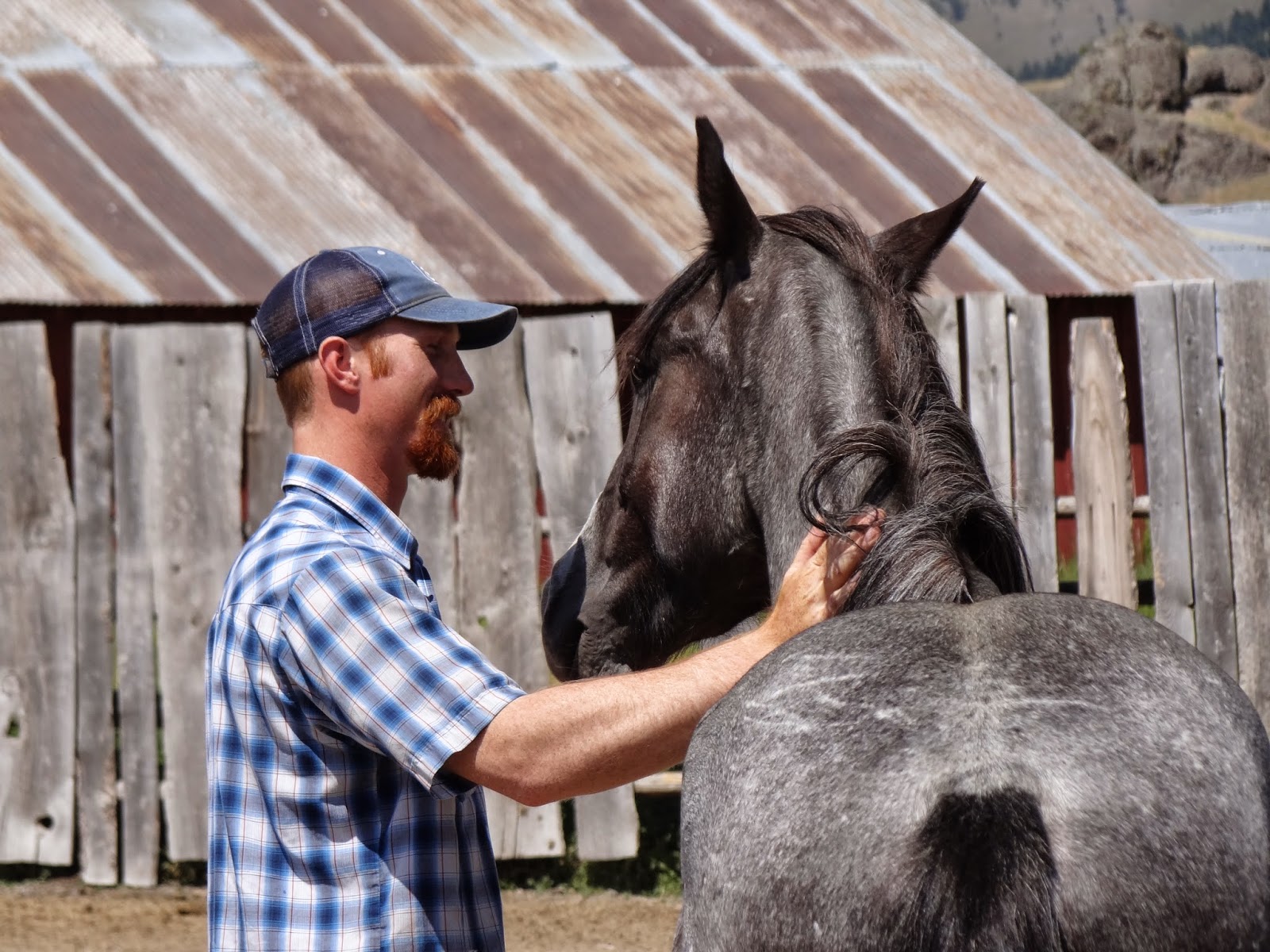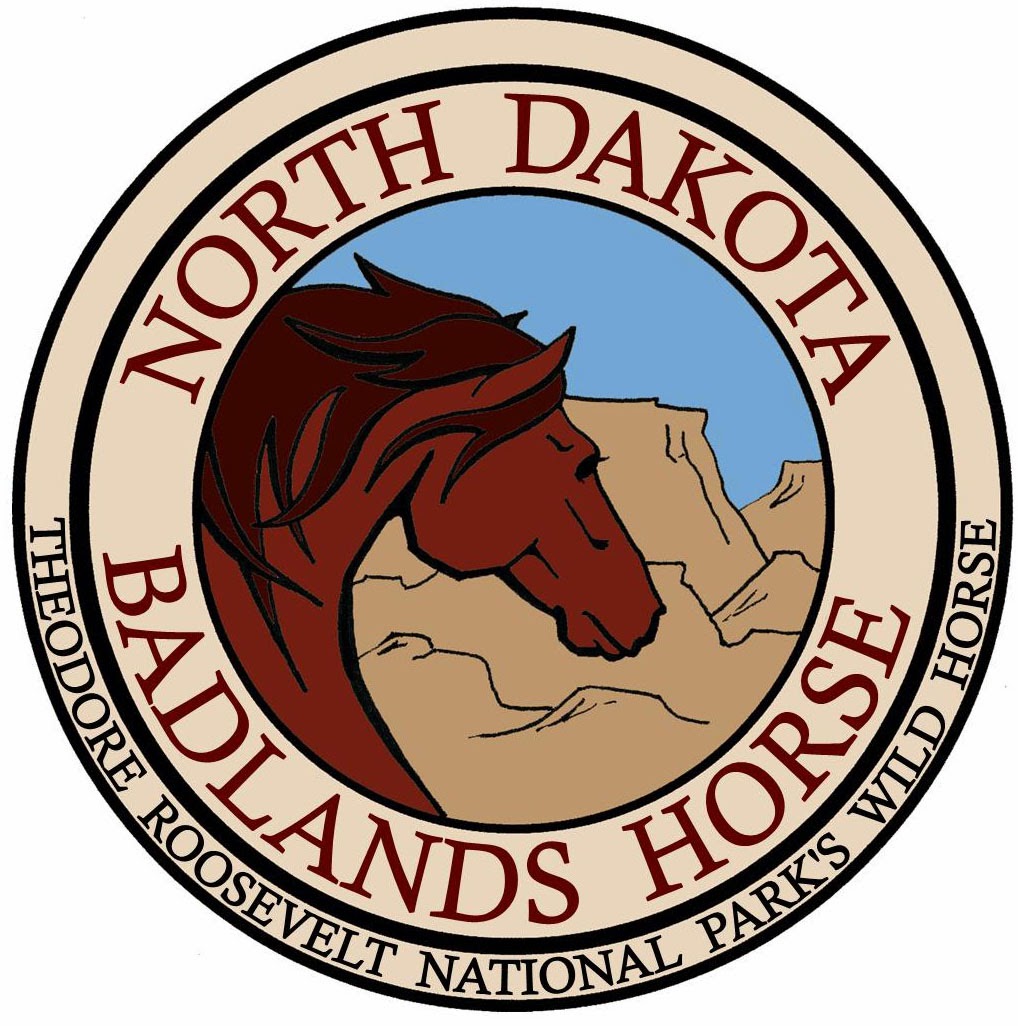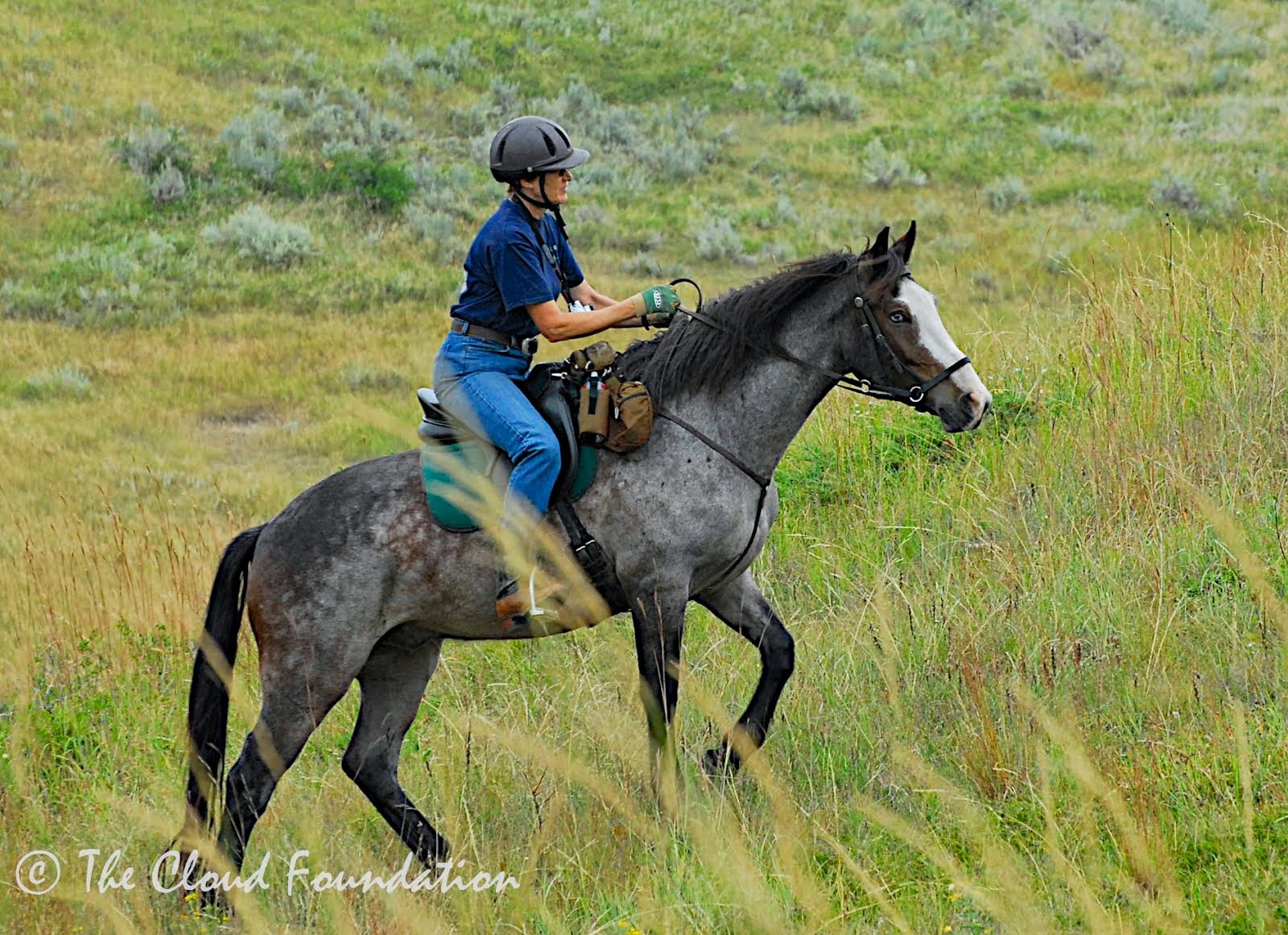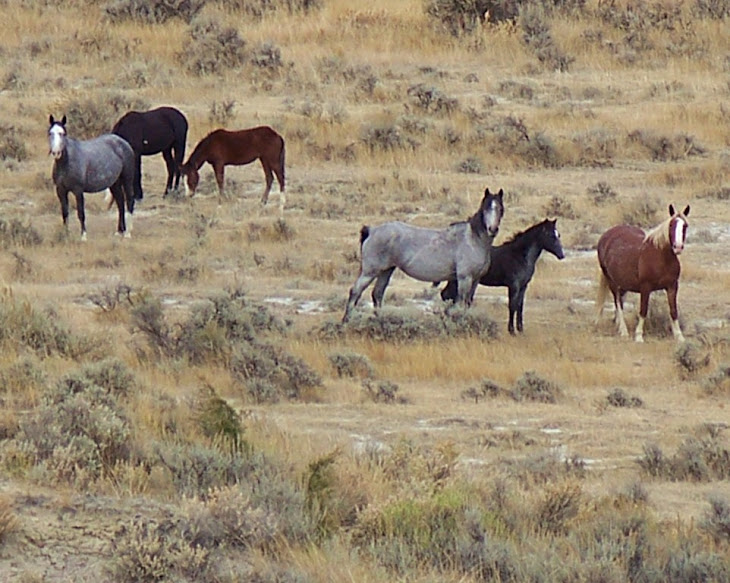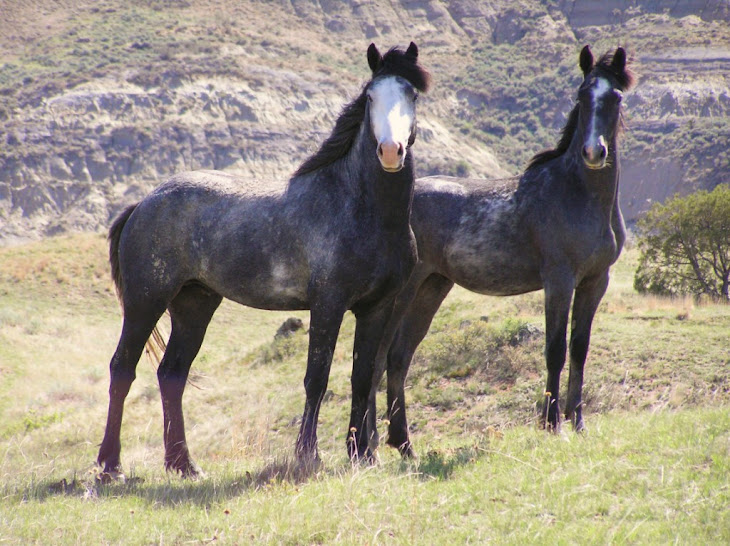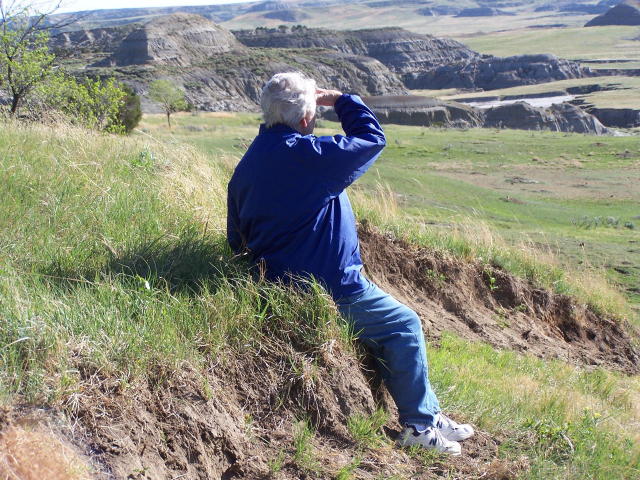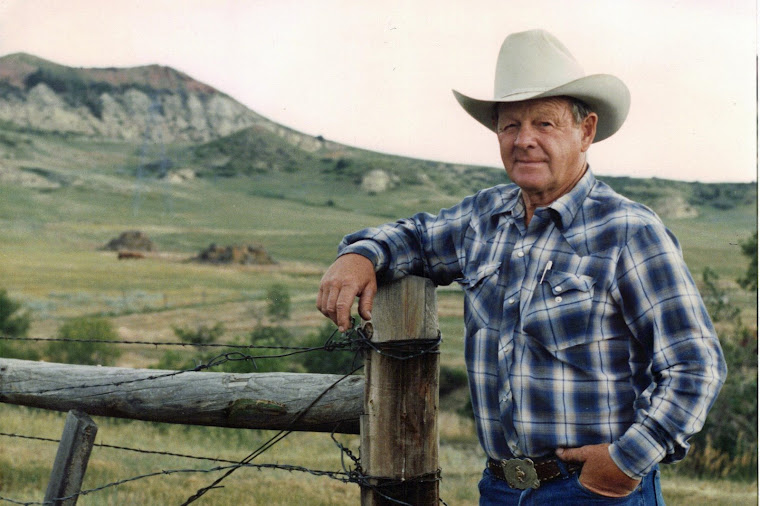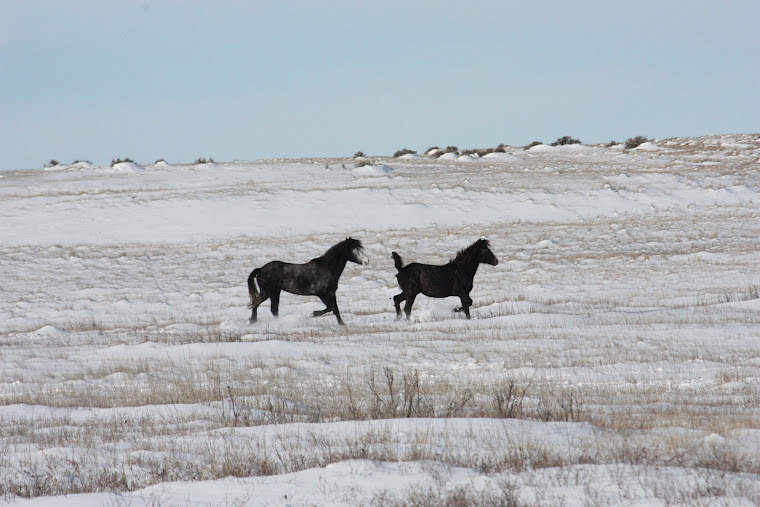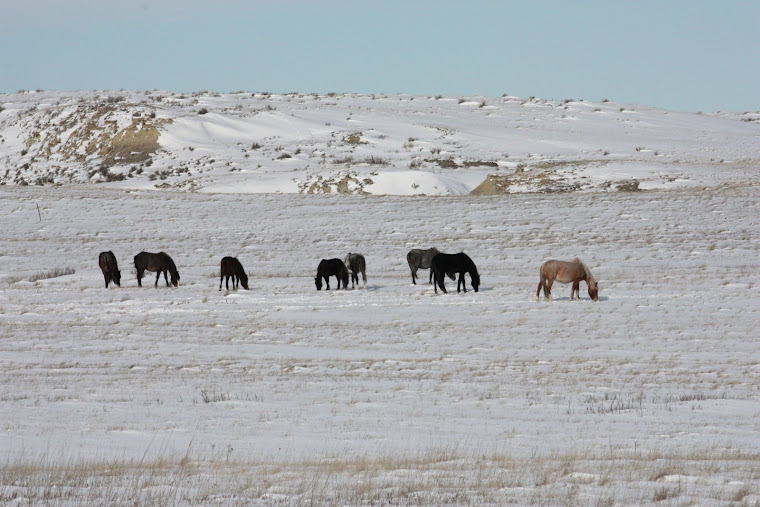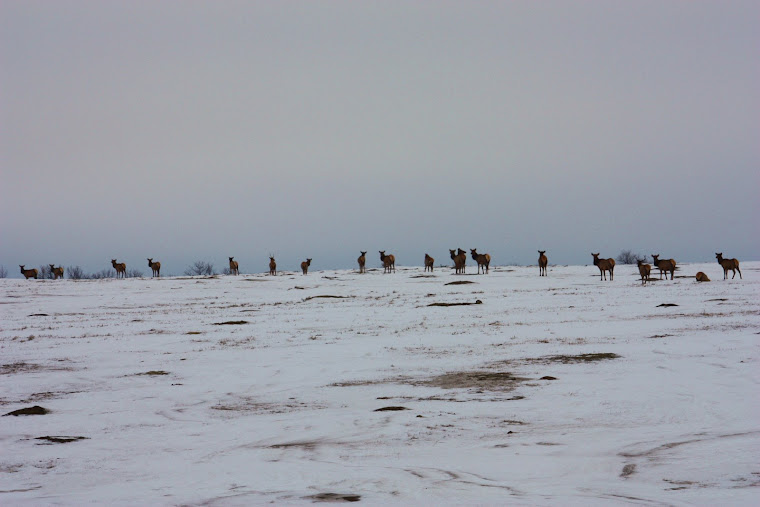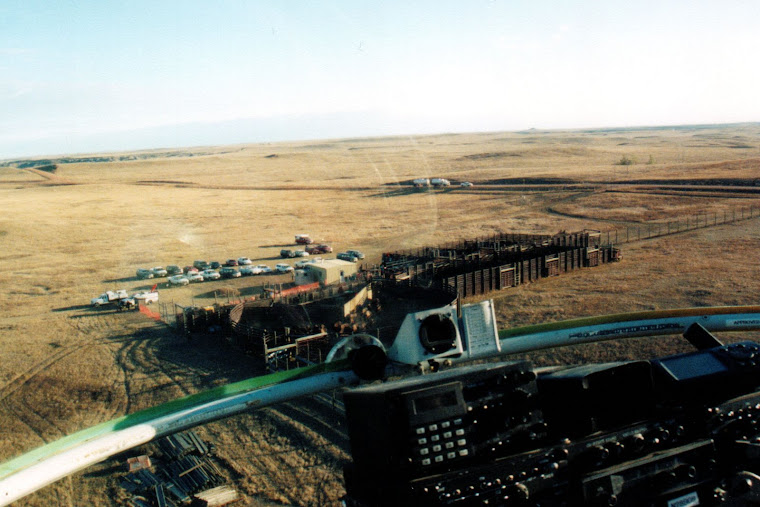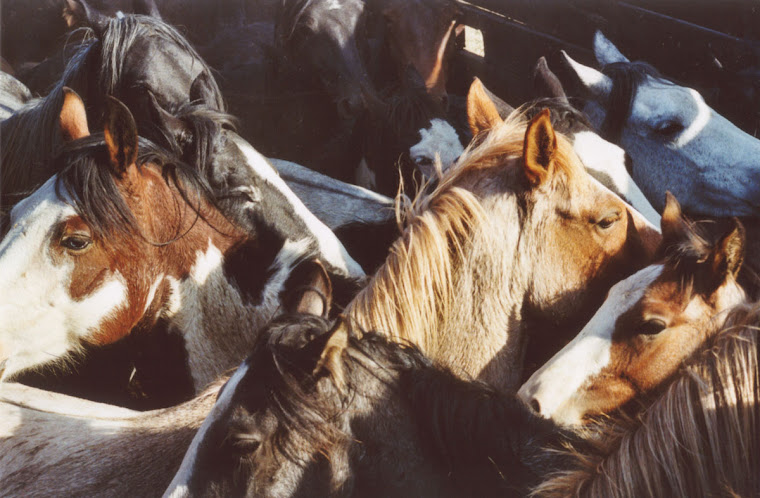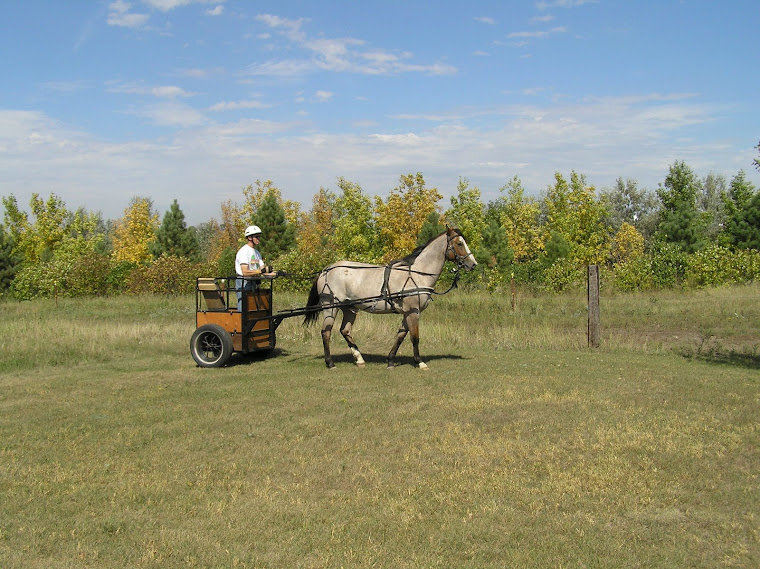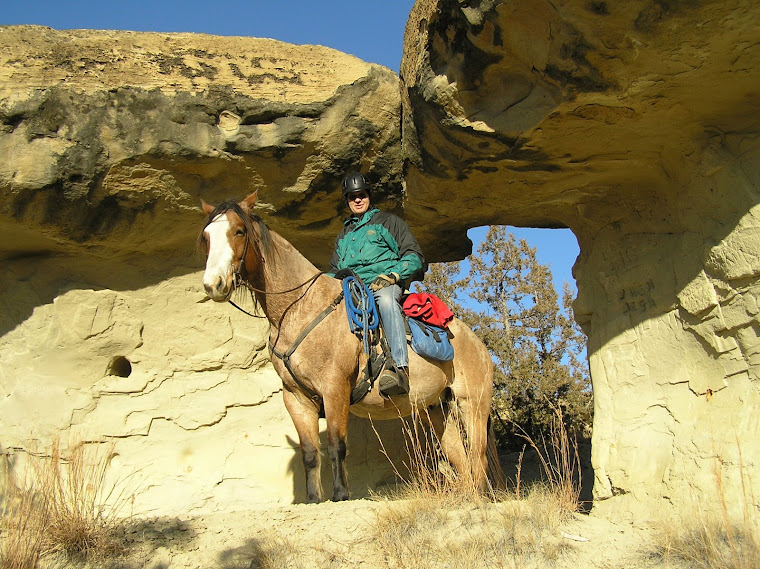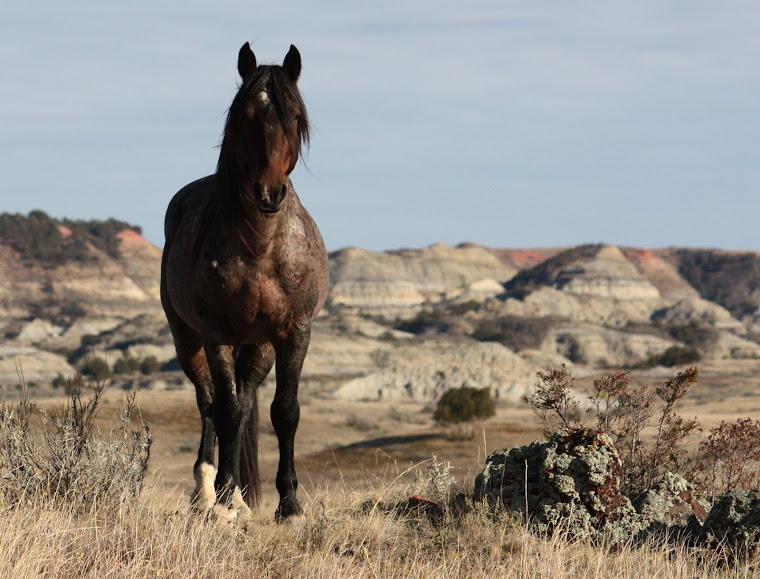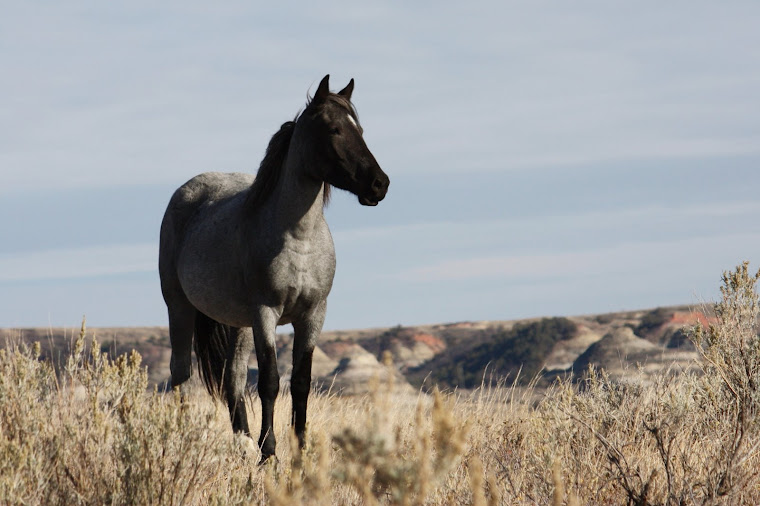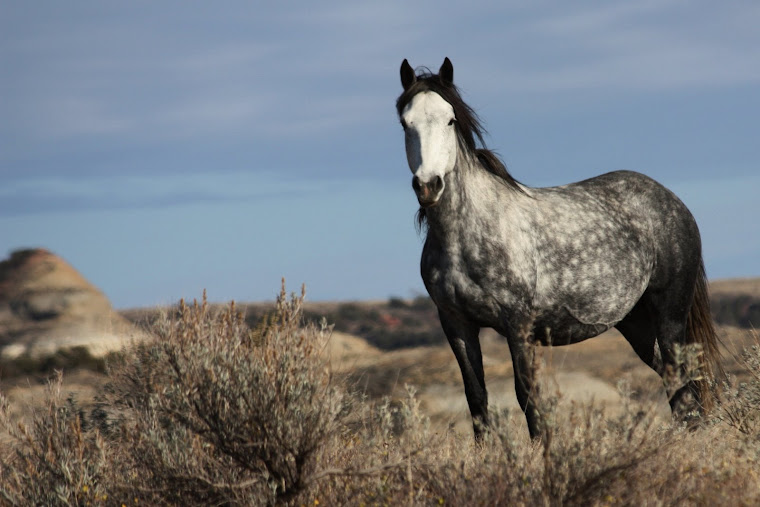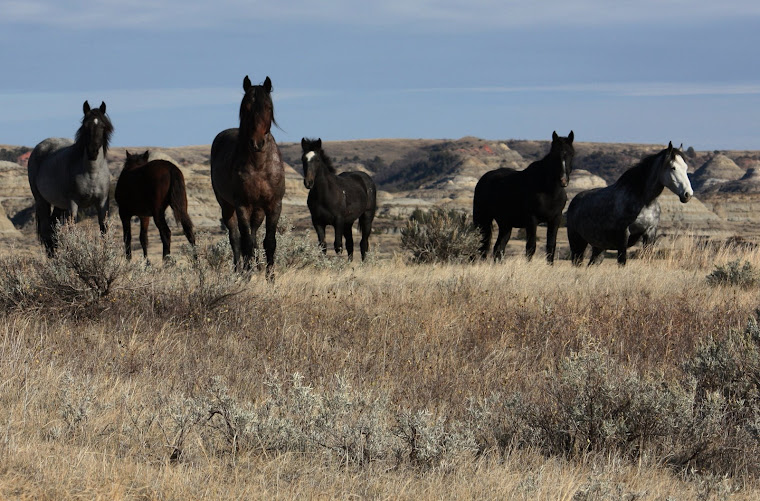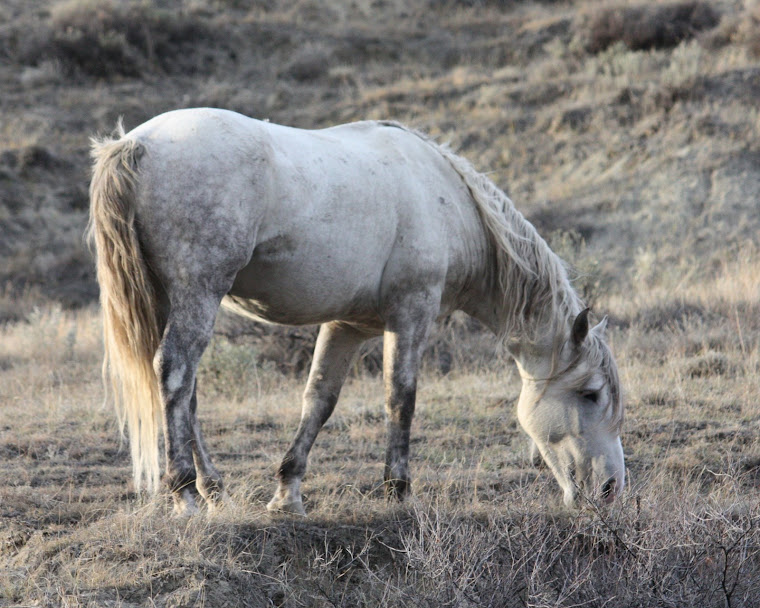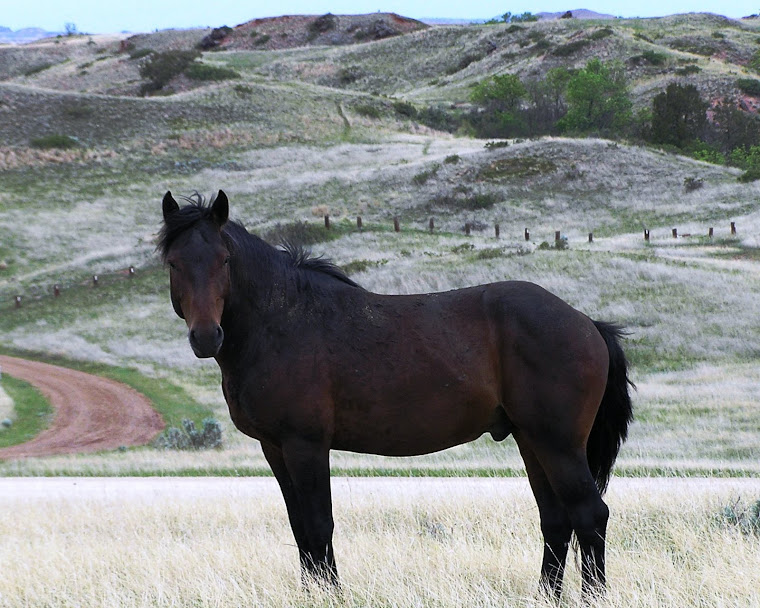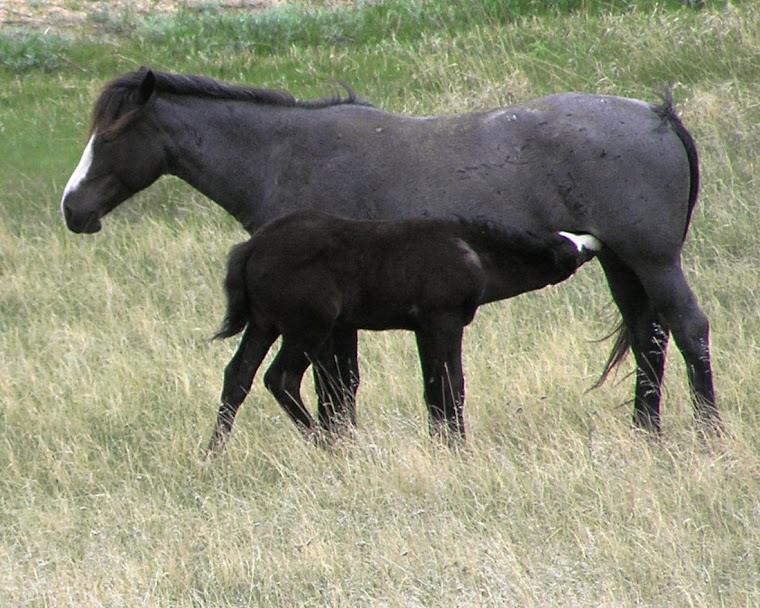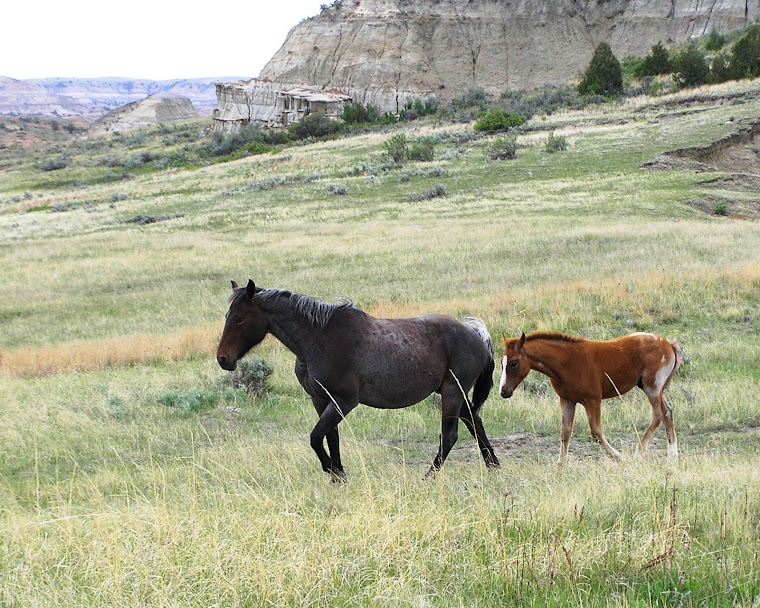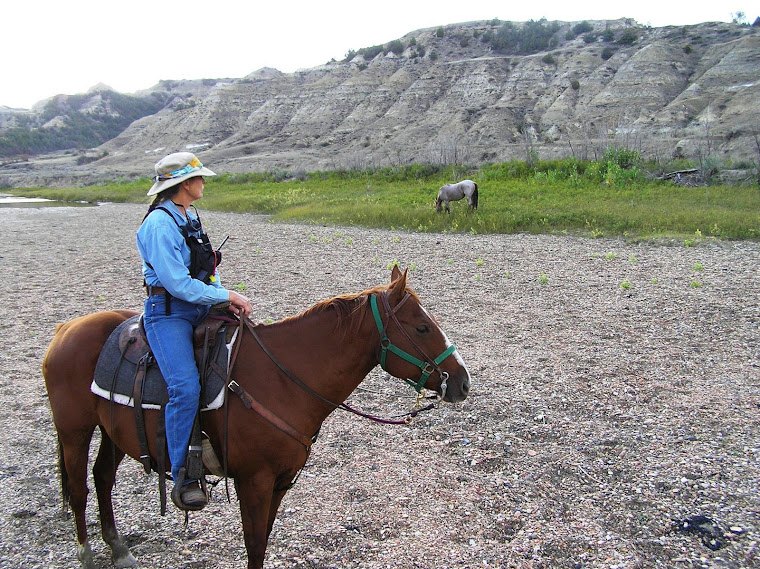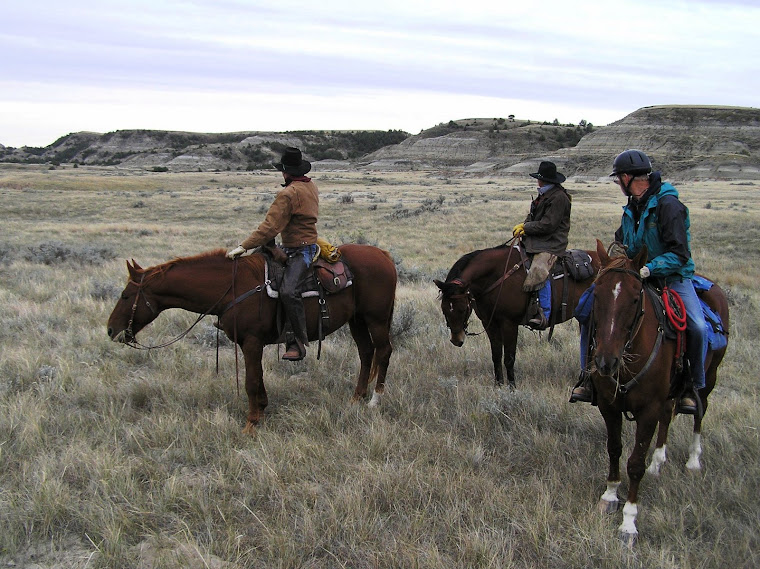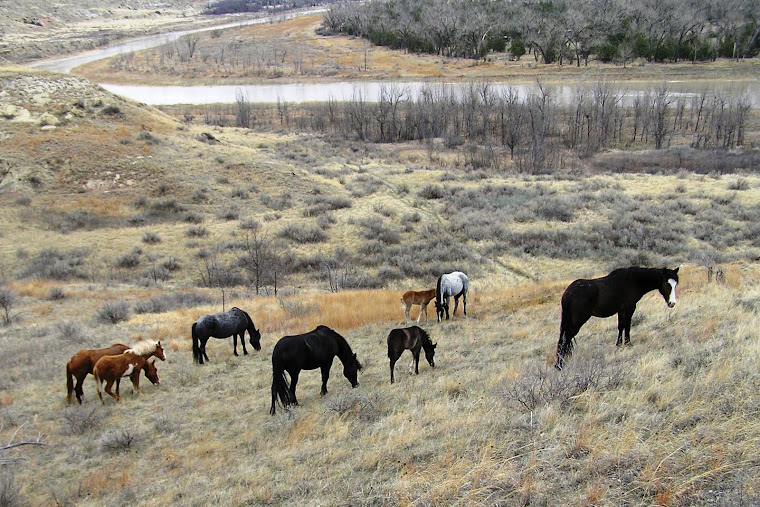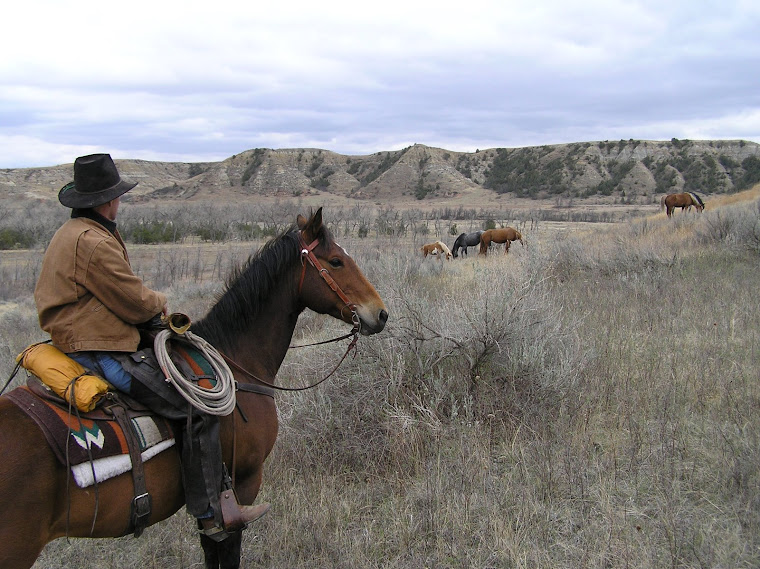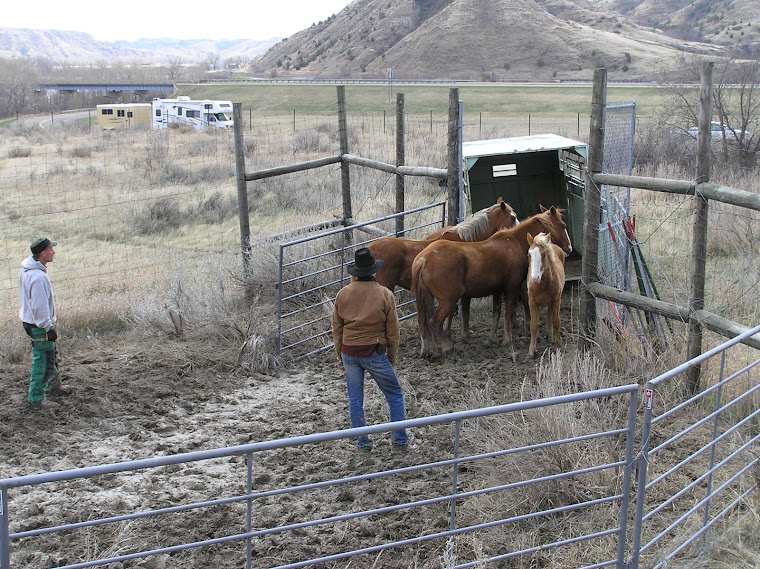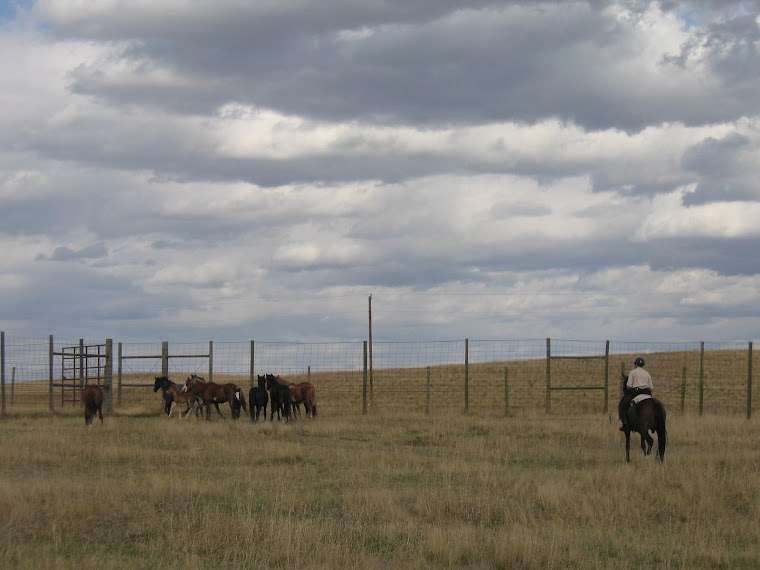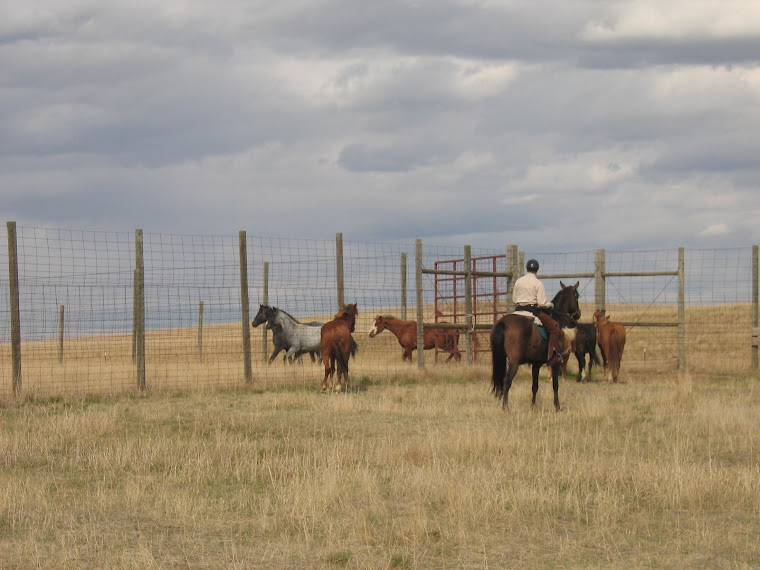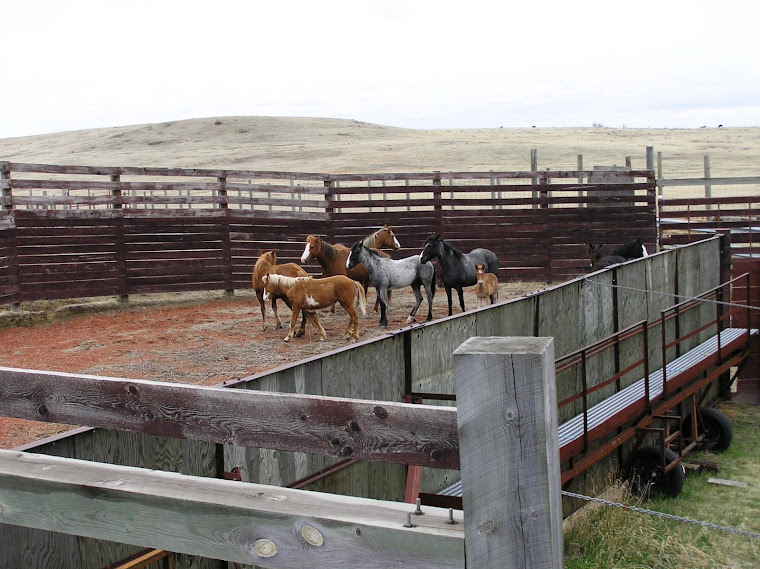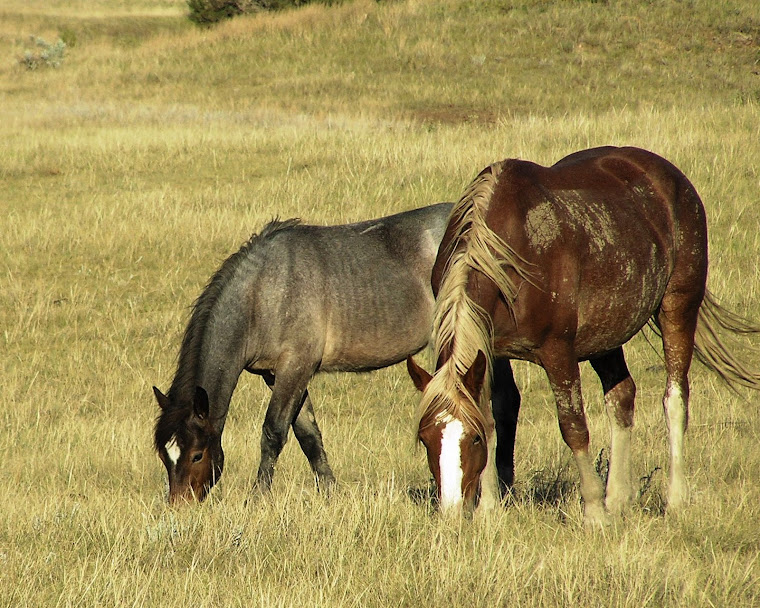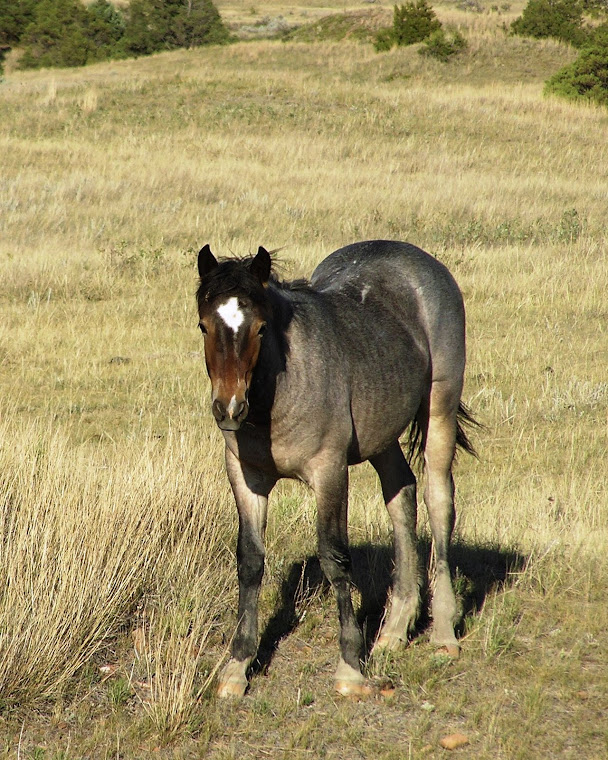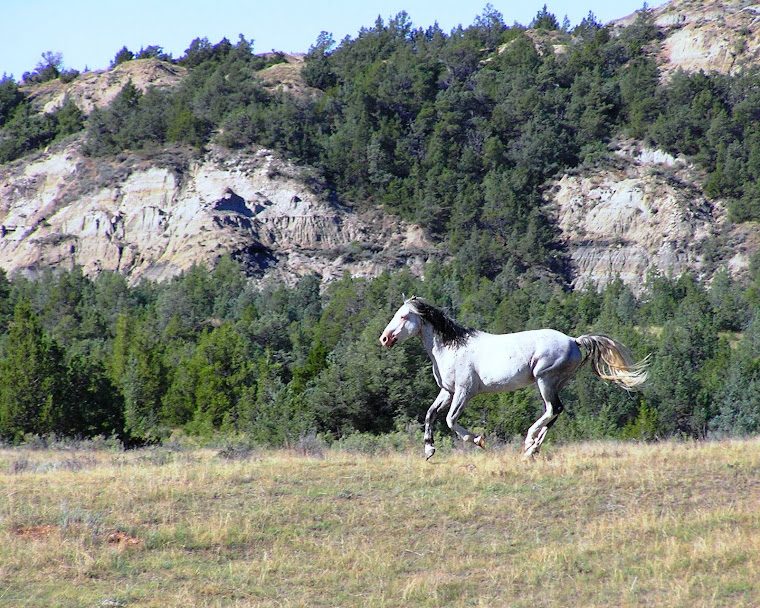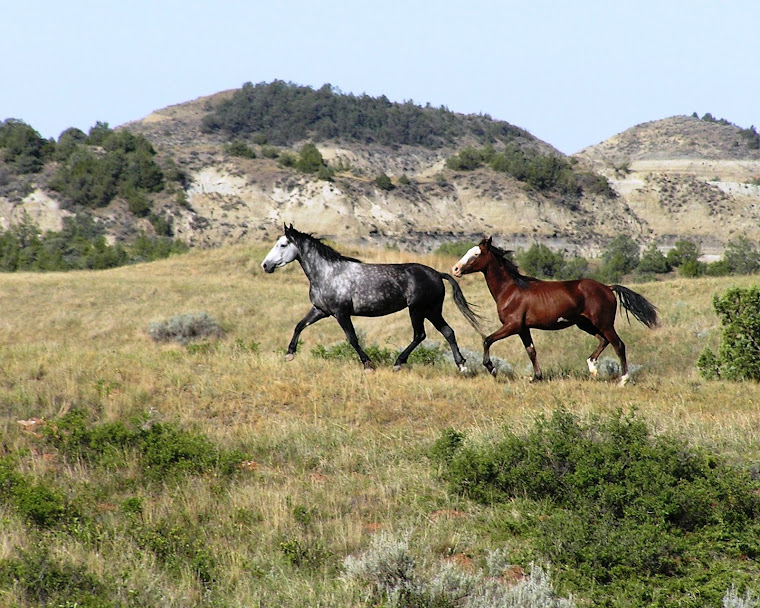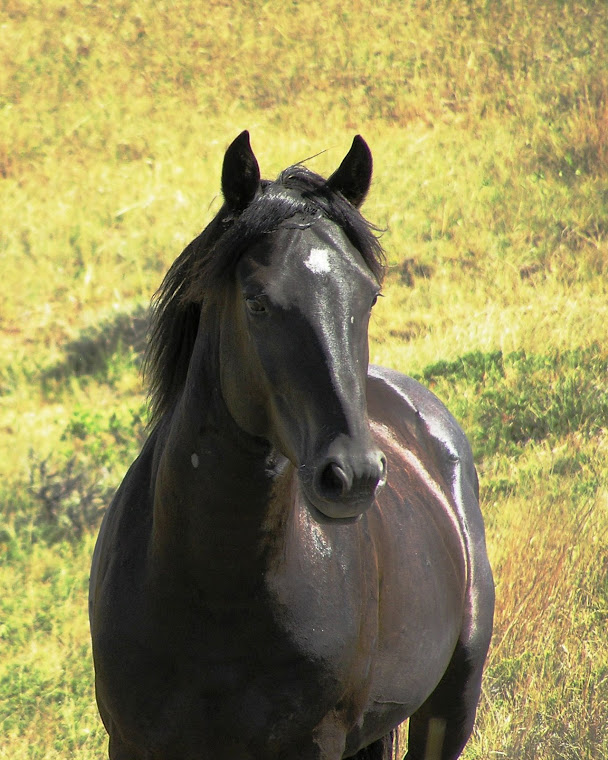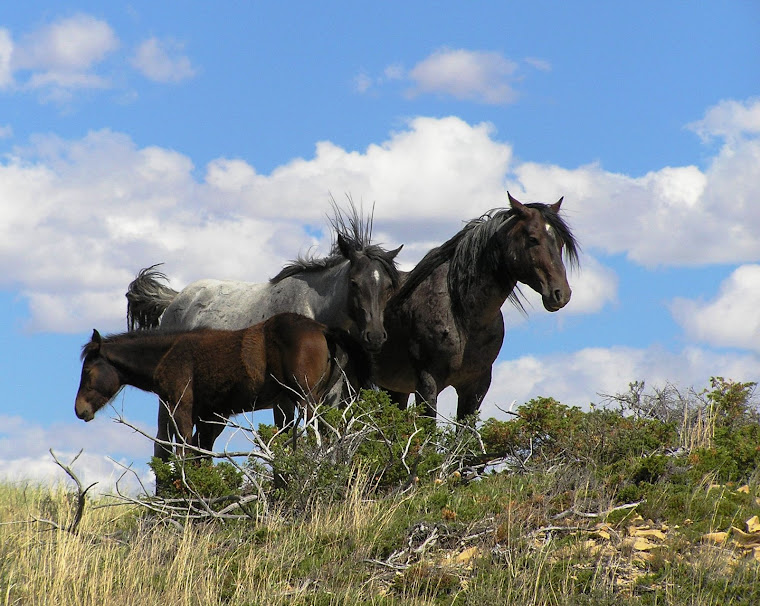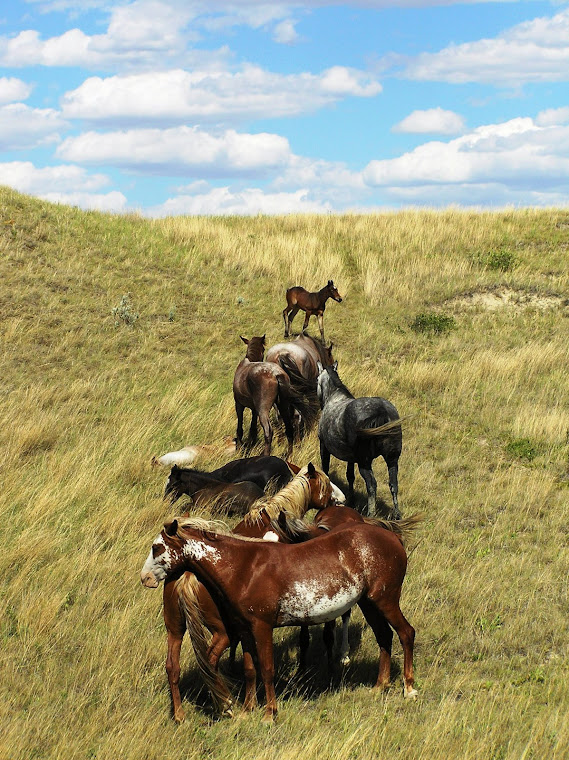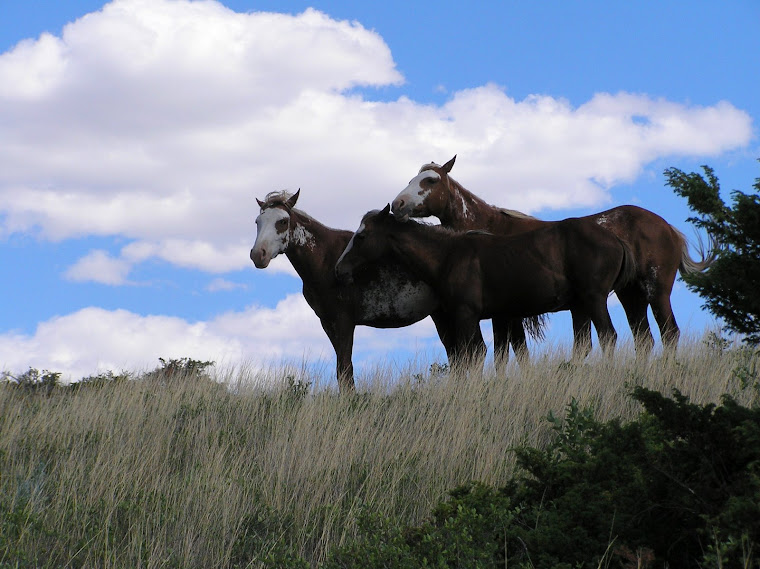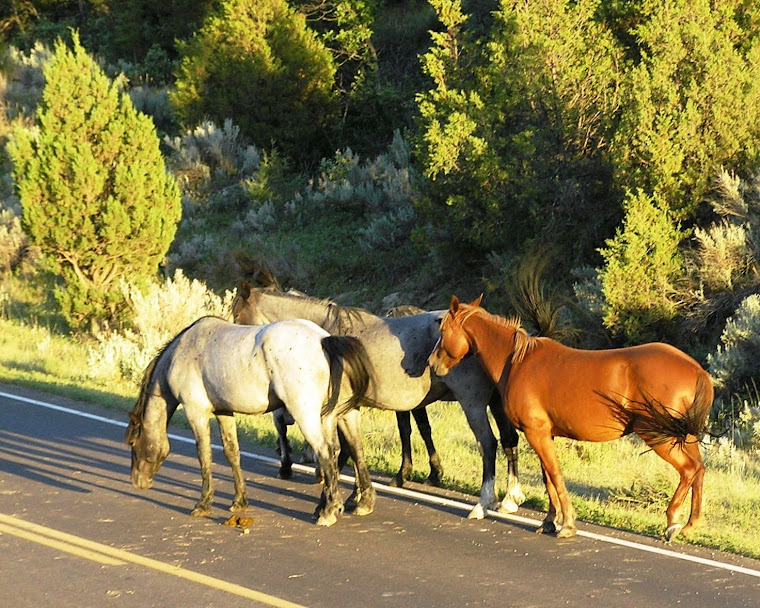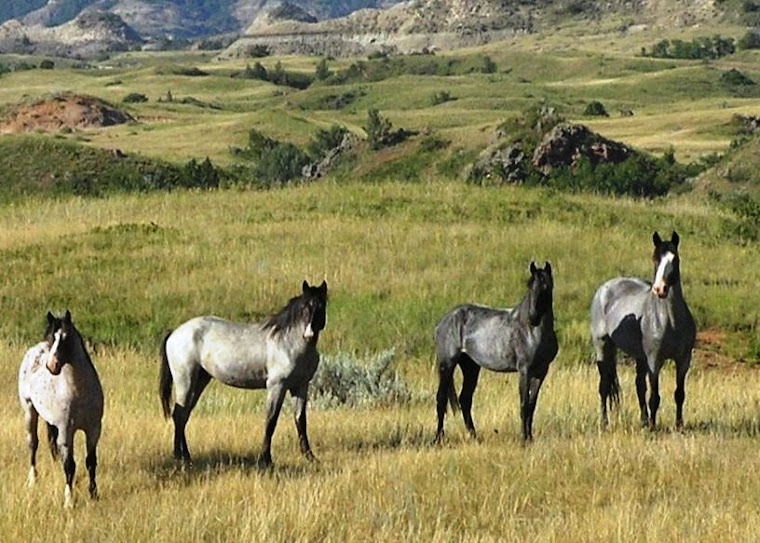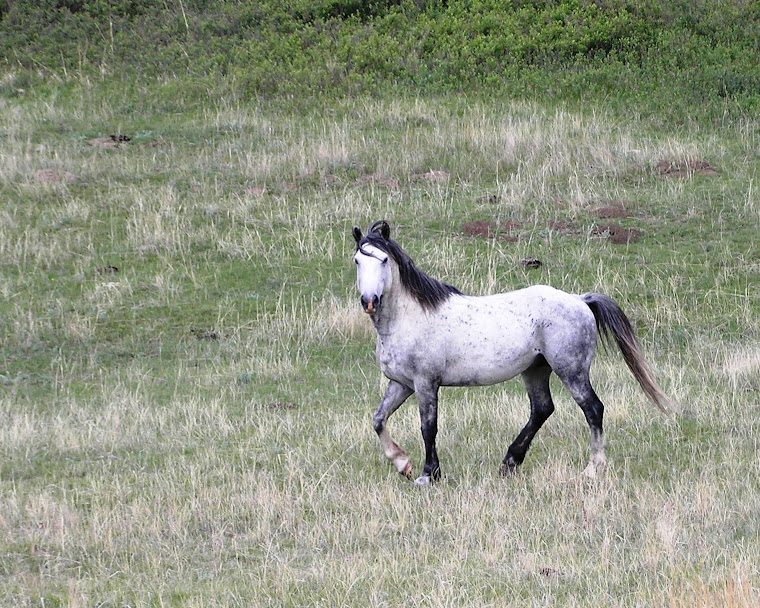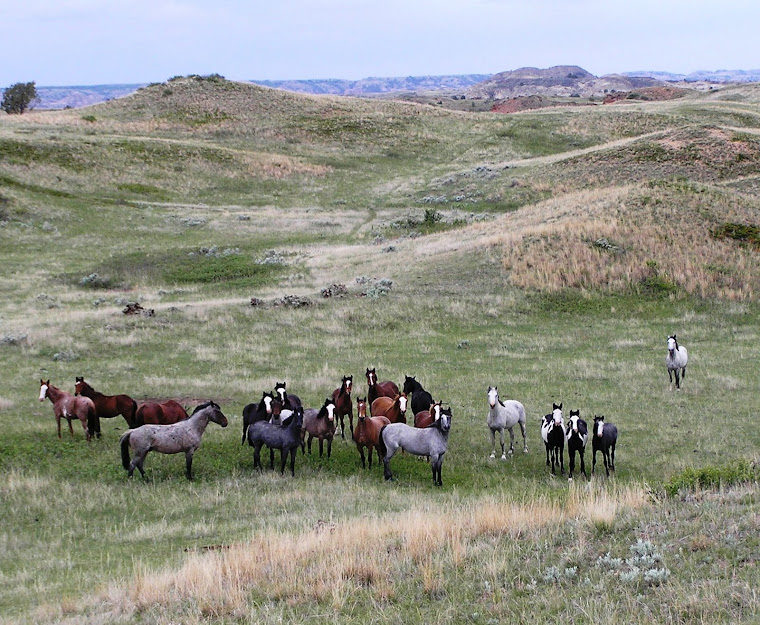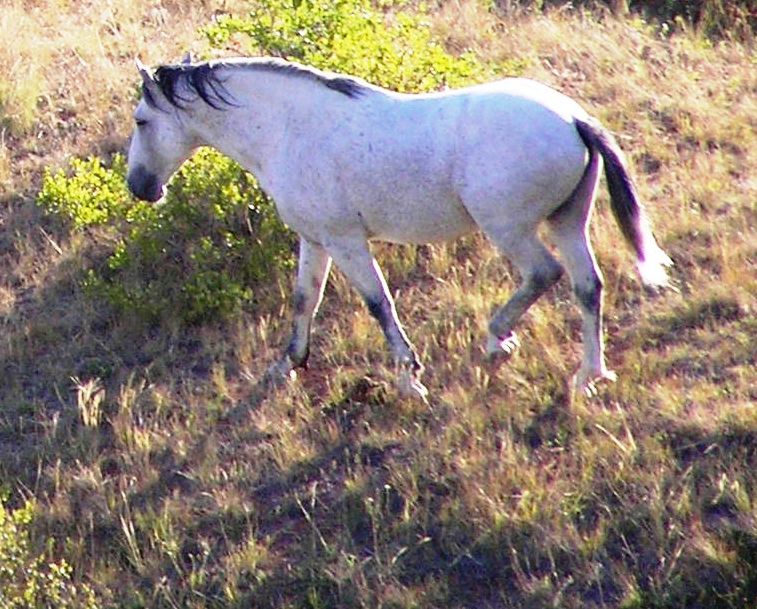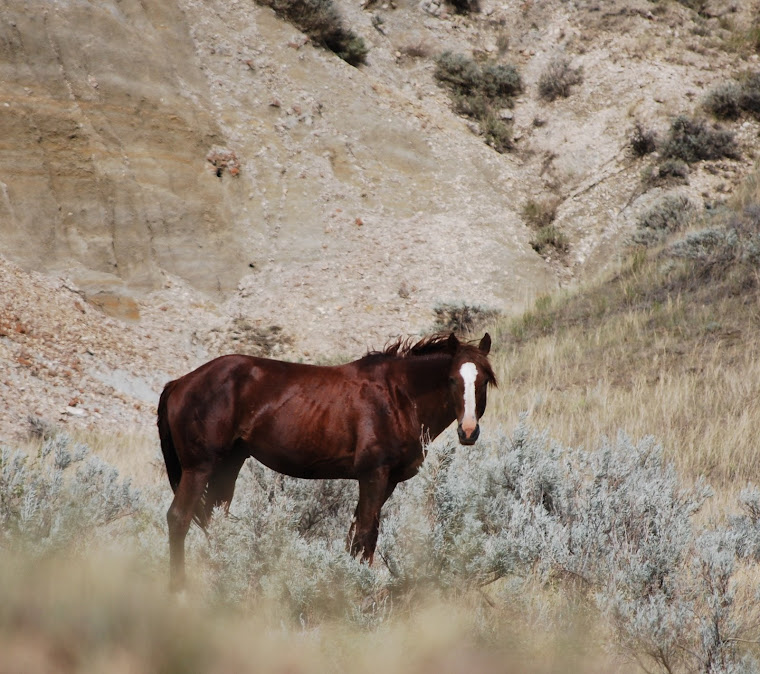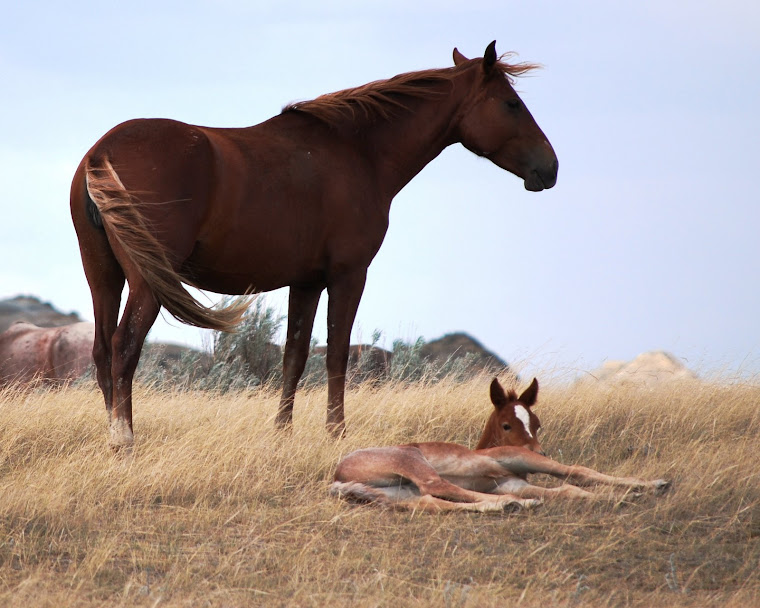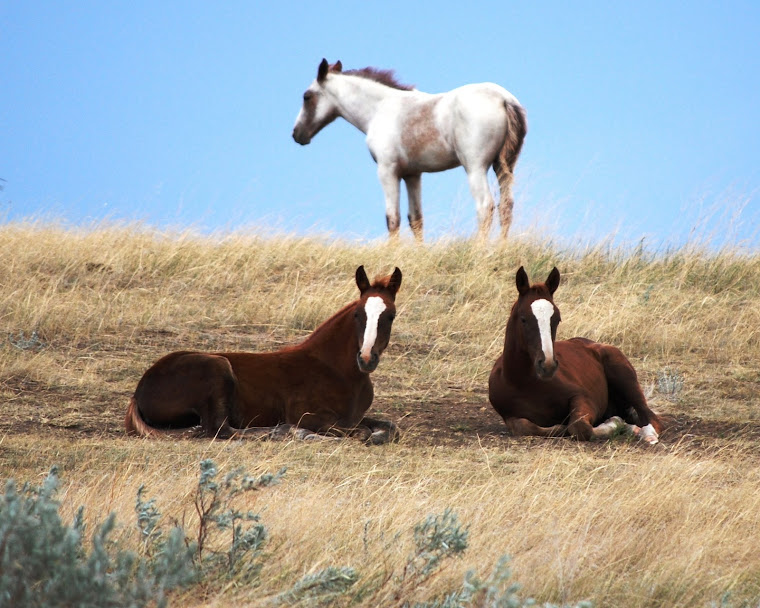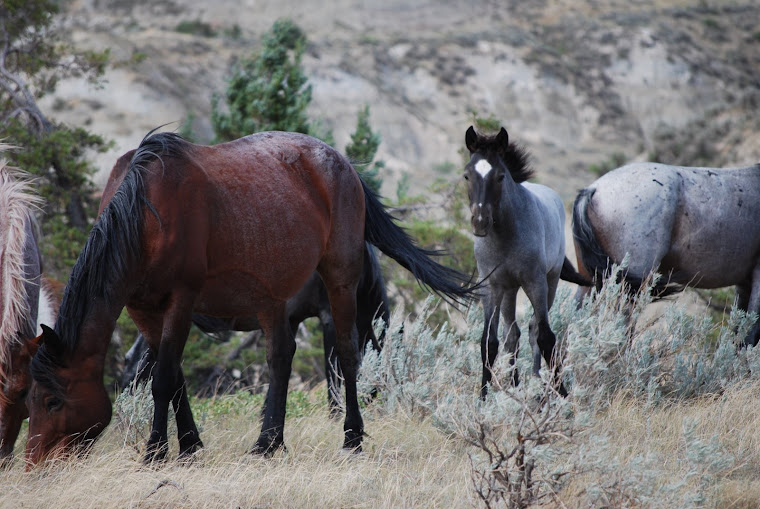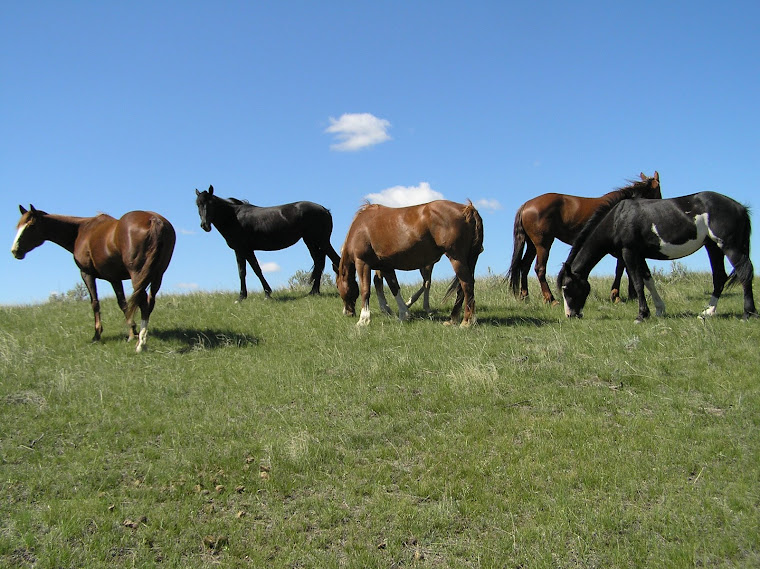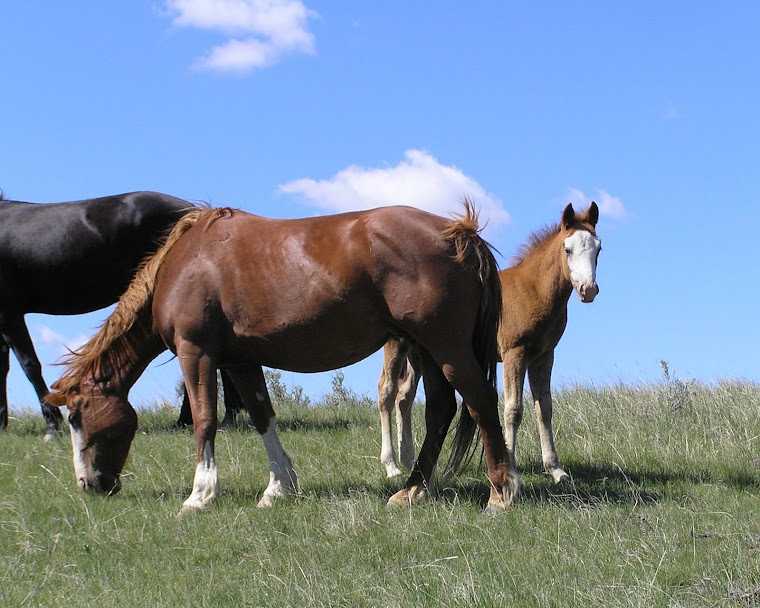The first two weeks of a foal's life are tenuous with predators wanting to feed on their tender flesh and other stallions with flailing feet and biting teeth attempting to steal their dams during the foal heats. The land that provides shelter and nourishment to the band can be dangerous to foals running precariously on spindly legs through deep spring snow, hidden sink holes, and rocky gullies. Around 30% of newborn foals die in the first two weeks of life, but the blue colt was one of the lucky ones. With each day he grew stronger, soon adding bright green grass to his diet of milk.
Some time during his gestation, his dam, Winter, another cute red roan, maiden mare, Little Brother's Girl, and another gray mare, Rain, with her two fillies, were stolen from his sire, Thunder Cloud. Thunder Cloud had most likely been injured in the fight with Blaze, as he was now running with another bachelor, Copper, while he gained strength to fight again. The mares stayed several months with the feisty bay roan stud, Blaze, but by spring, his blue roan sire had gained enough strength to win them back. Unfortunately for the blue colt, at one year old, he was now also considered a threat and Thunder Cloud chased him away from the band before the blue colt could learn the ways of a wild stallion from his majestic sire.
The colt didn't have much choice but to join another young stallion who had been fiercely driven from his natal band. Though he was curious when he saw us, the two leggeds he would come upon on a regular basis, he was young and shy, and didn't want to get too close to us. He would hide behind the older, braver, bald faced colt. The bald faced black colt was a son of High Star out of the beautiful gray mare, Bella. His family had been taken by Embers, so he too needed company. We called the black, Baldy and the blue, Bashful, because of his shy behavior. It was already apparent that both would gray like their dams, though both had colored sires. They spent that summer and the next munching on the rich green grass and playing with other young stallions in the "bachelor" bands. The younger bachelors were often referred to as the "young guns" because they cruised the Park play fighting and looking for mischief. It was an idyllic life for a young horse; the valleys were filled with lush grass, water was abundant, and the young Bashful had not matured enough to worry about acquiring a band of his own. However, on a rainy day in October, life took another change for Bashful, forcing him to make another choice and another step into an unknown world
The helicopters hung low in the sky that day because of the overcast sky. As they came closer, the young stallions became frightened and started to run away from them. They could already see the forms of other horses moving away in the distance, up, out of the flats and onto Boicourt Ridge, then down again into Talkington valley. Though the helicopters were a constant reminder, looming behind with their rhythmic roaring, thumping like the heart in Bashful's chest, they didn't get too close, so the horses settled into a comfortable trot that was easy for the suckling foals who had joined them along with their dams. Most of the mares moved obediently up the trail toward the east ridge, not wanting to challenge the throbbing beasts above them. One pretty, light red roan mare, Pale Lady, was not to be intimidated; finding just the right gully to make her move, she suddenly broke from the herd and led her golden dun colt, Marquis, to safety. The pilots saw her go and one attempted to go after her, but not wanting to lose the others, they let her return to freedom. Along with several other wild horses, Bashful ran into the catch pen and into another chapter of his life.
The trip though the handling facility can be very frightening, but the Park people stayed quiet and as gentle as they could be to move the horses, one at a time, through the chutes. Bashful was so distracted by all the sights and sounds above the chute as he was weighed and measured that he barely felt the needle as Doc expertly drew blood for a Coggins test. All Bashful wanted was to get out of this tight spot; he hated being confined by the high solid walls and tried to focus on the blue sky ahead of him. It must have seemed like an eternity to him, but he was soon released to run down the ally to a large pen where his buddy, Baldy, was already munching on grass. They spent three days in the large wooden pen. The green grass soon turned to brown as their sharp hooves churned it into mud. They were given fresh hay, which was difficult to learn how to eat, but filled their nervous stomachs. Water was provided from a tank that they soon learned would not hurt them. They must have wondered what would happen next.
The horses destined for sale did not have long to wait; soon large trucks came and they were herded onto the noisy, smelly stock trailers. What was more frightening was the fact that they moved under the horses' feet. The rocking and bumping must have seemed to never end, but before long they were unloaded at the sales barn in Dickinson. Nothing could have prepared these wild horses for the noise and stress of sales day with hundreds of people flocking through the alleys to gaze at the horses and plan their purchases. Bashful was particularly nervous, as he hated confinement; his only comfort were his buddies in the pen with him. On October 23, 2009 Bashful made another step that would be pivotal to his survival.
Stepping into the sales ring itself, he moved around in a daze with all the noise and lights confusing him. He could see what seemed to be hundreds of the two legged creatures surrounding him and two in particular, flailing flags at him. He couldn't get his bearings; where were his buddies; where was the light leading him out of this chaos? Then he saw it, the light of day high above him. Bashful took a huge leap in order to reach the light, a jump like he had never attempted before, to take him away from this cacophony of sounds and pressure, away to freedom. He gathered his body, tucked his front legs under his chest, rocked back on his haunches, and pushed with all the power and adrenalin within him. Up he soared toward the light, but he didn't make it to freedom; the cruel cable fence caught his hind leg and he came crashing into the crowd of people. The people screamed with fright and Bashful screamed with pain as the cable slashed into his leg. He pawed and fought furiously to get free, but it was not to be. A man under him felt his fury; a vidiographer, Brad, put himself in jeopardy and reached in to pull the man to safety; another man, Dan, threw his jacket over Bashful's head to try to calm him, but Bashful was in too much pain and terror to be calmed. He fought the jacket and anything else in reach of his teeth until his blood left crimson stains where once enthusiastic buyers had been.
What would happen to Bashful now? How would they remove him from the cable fence? Not able to watch any more, I left my safe vantage point in the auctioneer's box. Sure that they would have to euthanize him to get him off the fence, I couldn't bear to see it. As people milled around outside the barn I wondered what Bashful's fate would be inside. As the ambulance rushed away with the injured man, I learned that Bashful was removed alive from the fence and was recovering from sedation far back in the lot, away from the crowd, away from the noise, away from the auctioneer's cry as he finished the sale in the back barn. I could hardly be happy for Bashful, since he had decided his fate when he took that leap. Injured and deemed a rogue, no one would want to take him home now.
At that instant, Michael Sparling, who I had known since he was a little kid, son of our good friends, a Parelli Professional trainer, came to me and said, "I want that horse!" I was a little taken aback and just said I didn't know if they would sell him right away but to go for it. When the decision was made to sell him, Michael stepped in and bought Bashful for $35. Michael had now made a step that would forever save Bashful from certain death. Michael had seen in him a challenge to turn a horse others had rejected into one others would one day admire. Since Michael was taking on a new job in Washington state and Bashful was too injured to travel, it was decided to leave him with Michael's dad, Dan, in Bismarck. Michael spent a little time, even one night, with Bashful before his job took him to Seattle. It must have been sad to leave the nervous, blue colt behind.
It happened that Dan was also a Parelli Natural Horsemanship trainer and, having wanted to buy one of the wild ones himself, he couldn't resist starting to see what he could do with Bashful. Since Bashful was injured and Dan had injured his foot, his first tactic was to just sit outside the pen. Little by little and with generous use of treats, Dan was able to win Bashful over. He broke goals down into simple steps Bashful could understand and rewarded him for the right reactions.
With Dan's patience he gained Bashful's trust to the point of giving every part of his body up to be petted and scratched. Like other TRNP horses removed that fall, Bashful had winter ticks and loved to be scratched where they had been feeding on him. This became a way to keep Bashful coming back for attention. The scratching led to playing confidence building games, which led to under saddle training.
Over the summer Bashful became more and more reliable as a saddle horse. October 22, 2010 Dan rode Bashful back into the park. Bashful stepped with confidence onto the sun flooded ground where he was born, into the juniper lined valleys, across the rock strewn ridges, up the high buttes, and down the grassy meadows. He is in Dan's "herd of two" now and his future is bright.
 |
| Dan on Bashful at the 2013 Reunion Ride SCROLL TO THE BOTTOM OF THIS PAGE TO SEE MORE PHOTOS OF BASHFUL AS A FOAL AND HIS FIRST STEP BACK INTO THE PARK WITH DAN. |
.JPG)
.JPG)

.JPG)


.JPG)

.JPG)

.JPG)
.JPG)
.JPG)
.JPG)
.JPG)
.JPG)





.JPG)
